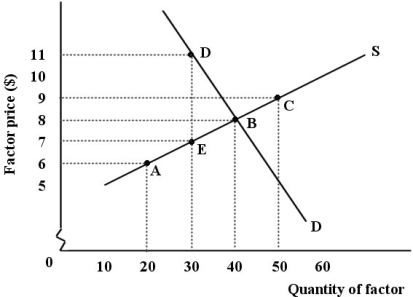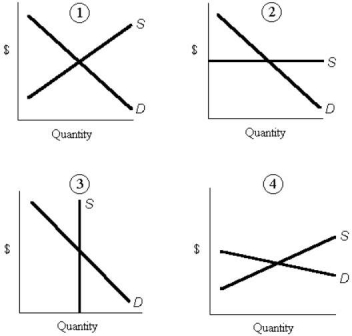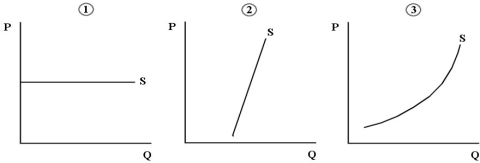A) a temporary factor-price differential.
B) a compensating differential.
C) an intrinsic difference.
D) an acquired difference.
E) an equilibrium differential.
Correct Answer

verified
Correct Answer
verified
Multiple Choice
The demand and supply curves shown below apply to a competitive market for a factor used in the production of widgets.
 FIGURE 13-2
-Refer to Figure 13-2. This factor market is initially in equilibrium at point B, but changes occur that cause the equilibrium to shift to point D S curve shifts left) . At the new equilibrium, total factor earnings compared to the initial equilibrium.
FIGURE 13-2
-Refer to Figure 13-2. This factor market is initially in equilibrium at point B, but changes occur that cause the equilibrium to shift to point D S curve shifts left) . At the new equilibrium, total factor earnings compared to the initial equilibrium.
A) decreased by $30
B) increased by $30
C) remained the same
D) increased by $10
E) increased by $330
Correct Answer

verified
Correct Answer
verified
Multiple Choice
Consider the following demand and supply curves in factor markets.
 FIGURE 13-4
-Refer to Figure 13-4. The panel that best illustrates the supply of a factor to a specific firm in the economy is
FIGURE 13-4
-Refer to Figure 13-4. The panel that best illustrates the supply of a factor to a specific firm in the economy is
A) 1.
B) 2.
C) 3.
D) 4.
E) 1 or 4.
Correct Answer

verified
Correct Answer
verified
Multiple Choice
The table below shows the total production for varying numbers of hours worked producing yo -yos. The firm sells its product and hires its workers in competitive markets.  TABLE 13-4
-Refer to Table 13-4. What is the marginal cost of the variable factor employed by this firm?
TABLE 13-4
-Refer to Table 13-4. What is the marginal cost of the variable factor employed by this firm?
A) $0
B) $5
C) $10
D) $20
E) $30
Correct Answer

verified
Correct Answer
verified
Multiple Choice
The three diagrams below each show a supply curve for oil tankers over a relatively short period of time.
 FIGURE 13-3
-Refer to Figure 13-3. Consider oil tankers as a factor of production for example, for the production of gasoline) . Which diagram shows the most mobility of this factor of production?
FIGURE 13-3
-Refer to Figure 13-3. Consider oil tankers as a factor of production for example, for the production of gasoline) . Which diagram shows the most mobility of this factor of production?
A) diagram 1
B) diagram 2
C) diagram 3
D) none of the diagrams
E) each diagram shows mobility
Correct Answer

verified
Correct Answer
verified
Multiple Choice
Choose the statement that best describes the difference between ʺeconomic rentʺ and other factor payments.
A) Economic rent is unearned income of the factor whereas other payments are earned.
B) Economic rent is not a cost to the firm but other payments are.
C) A reduction in economic rent will not reduce the availability of the factor whereas reducing other payments of factors will reduce their availability.
D) There is no difference between economic rent and other factor payments.
E) Economic rent is the sum of all factor payments.
Correct Answer

verified
Correct Answer
verified
Multiple Choice
If a firm is a perfect competitor in its product market, the marginal product of a factor multiplied by the productʹs price equals
A) marginal cost.
B) marginal profit.
C) total revenue.
D) marginal revenue.
E) marginal revenue product.
Correct Answer

verified
Correct Answer
verified
Multiple Choice
Consider labour that is hired for $18 per hour. If the last hour hired produces 8 units of output which sells for $2 per unit, that labour-hour adds to the firmʹs profit and so labour should be hired.
A) -$128; more
B) -$2; less
C) $16; less
D) $16; more
E) $0; no
Correct Answer

verified
Correct Answer
verified
Multiple Choice
The demand and supply curves shown below apply to a competitive market for a factor used in the production of widgets.
 FIGURE 13-2
-Refer to Figure 13-2. This factor market is in equilibrium at point B. Which of the following statements best describes factor payments at point B?
FIGURE 13-2
-Refer to Figure 13-2. This factor market is in equilibrium at point B. Which of the following statements best describes factor payments at point B?
A) total income paid to the factor is $8
B) total of economic rent plus transfer earnings is $320
C) total factor earnings are $320 and the 40th unit earns zero rent
D) total factor earnings are $320 and the 40th unit earns economic rent of $8
E) economic rent to the 40th unit is $320
Correct Answer

verified
Correct Answer
verified
Multiple Choice
Consider a firmʹs demand curve for labour. If a technological change makes it harder to substitute capital for labour, the demand curve for labour
A) shifts parallel to the right.
B) shifts parallel to the left.
C) becomes less elastic.
D) becomes more elastic.
E) is not affected.
Correct Answer

verified
Correct Answer
verified
Multiple Choice
The table below shows the total production for varying numbers of hours worked producing yo -yos. The firm sells its product and hires its workers in competitive markets.  TABLE 13-4
-Refer to Table 13-4. Which of the following statements best describes the situation of this firm when it is employing 15 hours of labour? The 15th hour of labour hired
TABLE 13-4
-Refer to Table 13-4. Which of the following statements best describes the situation of this firm when it is employing 15 hours of labour? The 15th hour of labour hired
A) adds $5 to revenue, but costs $10 to hire, so this firm should hire less labour.
B) adds $20 to revenue, but only costs $10 to hire, so this firm should hire more labour.
C) adds $10 to revenue and costs $10 to hire, so this firm is maximizing its profit at 15 hours of labour.
D) adds $50 to revenue, but only costs $10 to hire, so this firm should hire more labour.
E) adds $2 to revenue, but costs $10 to hire, so this firm should hire less labour.
Correct Answer

verified
Correct Answer
verified
Multiple Choice
If at a particular wage rate in a competitive labour market the quantity demanded of labour is less than quantity supplied of labour, then
A) some workers will begin to accept lower wages and induce employers to hire more workers.
B) there will be a shortage of labour, thereby increasing the equilibrium wage rate.
C) the demand curve for labour will shift to the right.
D) the supply curve for labour will shift to the right.
E) a black market for labour will form, with firms offering workers very high wages.
Correct Answer

verified
Correct Answer
verified
Multiple Choice
The elasticity of supply of computer-game programmers will generally be greater if we are analyzing the amount supplied to
A) the whole economy in the short run.
B) the whole economy in the long run.
C) a particular industry in the short run.
D) a particular industry in the long run.
E) a specific firm.
Correct Answer

verified
Correct Answer
verified
Multiple Choice
Consider the following demand and supply curves in factor markets.
 FIGURE 13-4
-Suppose that the municipal government of Calgary decides to tax economic rent on a highly sought -after piece of land. The result would be
FIGURE 13-4
-Suppose that the municipal government of Calgary decides to tax economic rent on a highly sought -after piece of land. The result would be
A) little or no effect on the supply of the land.
B) an increase in the supply of the land.
C) a reduction in the supply of land.
D) a shift of the entire tax onto the consumer.
E) a rise in the price of land.
Correct Answer

verified
Correct Answer
verified
Multiple Choice
Consider a small firm that is producing winter jackets. It can lease an additional sewing machine for one month for $1200. With this additional machine, the firm can produce an additional 7 jackets during that time period that it sells for $250 each. Hiring the marginal machine adds to the firmʹs profit and so it should the machine.
A) -$1200; not lease
B) $0; be indifferent as to whether to lease
C) $1200; lease
D) $550; lease
E) $1750; lease
Correct Answer

verified
Correct Answer
verified
Multiple Choice
The hypothesis of equal net advantage explains why
A) two workers doing the same job in the same office are sometimes paid different wage rates.
B) higher wages must be paid to entice workers to accept less desirable occupations or a less desirable location.
C) the supply of unskilled labour in Canada is as great as it is.
D) a hard-working employee may get paid less than other employees.
E) lower wages are paid to workers with less qualifications.
Correct Answer

verified
Correct Answer
verified
Multiple Choice
Other things equal, if a particular province has some non-monetary advantages, such as a temperate climate, the wage rate in that province will be
A) higher than national average and the market will be in equilibrium.
B) higher than national average and the market will be in disequilibrium.
C) lower than national average and the market will be in equilibrium.
D) lower than national average and the market will be in disequilibrium.
E) the same as any other province.
Correct Answer

verified
Correct Answer
verified
Multiple Choice
Consider labour that is hired for $18 per hour. If the last hour of labour hired produces 8 units of output which sells for $10 per unit, that labour-hourʹs marginal revenue product is
A) $1.20.
B) $4.44.
C) $64.
D) $80.
E) $144.
Correct Answer

verified
Correct Answer
verified
Multiple Choice
Consider the following table for a firm. The first column shows the number of units of a variable factor of production employed by the firm.  TABLE 13-2
-Refer to Table 13-2. Suppose the firm is a perfect competitor and faces a given price of the product equal to $2 per unit. The marginal revenue product of the 5th unit of the factor is
TABLE 13-2
-Refer to Table 13-2. Suppose the firm is a perfect competitor and faces a given price of the product equal to $2 per unit. The marginal revenue product of the 5th unit of the factor is
A) $128.
B) $148.
C) $20.
D) $40.
E) $2.
Correct Answer

verified
Correct Answer
verified
Multiple Choice
Assume that the market for farmland in the fruit-growing region of southwestern Ontario is perfectly competitive. Which of the following will shift the demand curve for this land to the left? 1) a decrease in demand for Canadian-grown fruit; 2) a change in consumer preferences toward eating more fruit; 3) scientific reports that confirm a reduction in water supply to the region.
A) 1 and 2
B) 2 and 3
C) 1 and 3
D) 1 only
E) 3 only
Correct Answer

verified
Correct Answer
verified
Showing 101 - 120 of 124
Related Exams